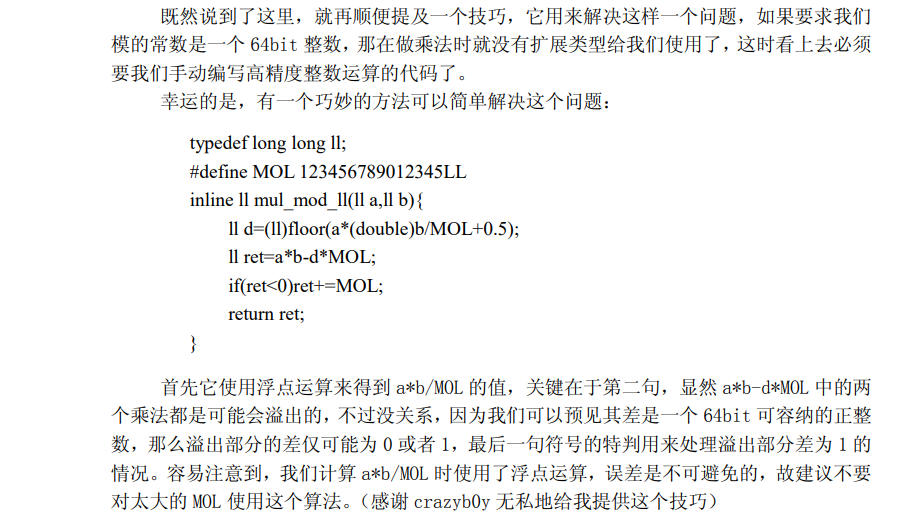LG4718 【模板】Pollard-Rho算法 和 [Cqoi2016]密钥破解
Pollard-Rho算法
总结了各种卡常技巧的代码:
#define int long long
typedef __int128 LL;
IN int fpow(int a,int b,int mod){
int ans=1%mod;
for(;b;b>>=1,a=(LL)a*a%mod)
if(b&1) ans=(LL)ans*a%mod;
return ans;
}
CO int p[3]={2,61,10007};
bool Miller_Rabbin(int n){
if(n==1) return 0;
for(int i=0;i<3;++i)
if(p[i]==n) return 1;
for(int i=0;i<3;++i){
if(fpow(p[i],n-1,n)!=1) return 0;
int k=n-1,r=0; // k*2^r
while(~k&1) k>>=1,++r;
int last=fpow(p[i],k,n);
for(int i=1;i<=r;++i){
int now=(LL)last*last%n;
if(now==1 and last!=1 and last!=n-1) return 0;
last=now;
}
}
return 1;
}
int Pollard_Rho(int n){
if(Miller_Rabbin(n)) return n;
while(1){
int seed=(rand()|rand()<<15)%n;
auto calc=[seed,n](int x){
return ((LL)x*x+seed)%n;
};
int x=(rand()|rand()<<15)%n,y=x;
int sum=1,step=0,point=1;
while(sum){
x=calc(x);
sum=(LL)sum*(y+n-x)%n;
if(++step==point){
int d=__gcd(sum,n);
if(1<d and d<n) return max(Pollard_Rho(d),Pollard_Rho(n/d));
y=x,point<<=1;
}
}
}
}
void real_main(){
int n=read<int>();
int ans=Pollard_Rho(n);
if(ans==n) puts("Prime");
else printf("%lld\n",ans);
}
signed main(){
// freopen("LG4718.in","r",stdin),freopen("LG4718.out","w",stdout);
srand(20030506);
for(int T=read<int>();T--;) real_main();
return 0;
}
密钥破解
一种非对称加密算法的密钥生成过程如下:
- 任选两个不同的质数 p ,q
- 计算 N=pq , r=(p-1)(q-1)
- 选取小于r ,且与 r 互质的整数 e
- 计算整数 d ,使得 ed≡1 mod r
- 二元组 (N,e) 称为公钥,二元组 (N,d) 称为私钥
当需要加密消息 n 时(假设 n 是一个小于 N 整数,因为任何格式的消息都可转为整数表示),使用公钥 (N,e),按照
n^e≡c mod N
运算,可得到密文 c 。
对密文 c 解密时,用私钥 (N,d) ,按照
c^d≡n mod N
运算,可得到原文 n 。算法正确性证明省略。
由于用公钥加密的密文仅能用对应的私钥解密,而不能用公钥解密,因此称为非对称加密算法。通常情况下,公钥由消息的接收方公开,而私钥由消息的接收方自己持有。这样任何发送消息的人都可以用公钥对消息加密,而只有消息的接收方自己能够解密消息。
现在,你的任务是寻找一种可行的方法来破解这种加密算法,即根据公钥破解出私钥,并据此解密密文。
Input
输入文件内容只有一行,为空格分隔的j个正整数e,N,c。N<=2^62,c<N
Output
输出文件内容只有一行,为空格分隔的k个整数d,n。
Sample Input
3 187 45
Sample Output
107 12
//样例中 p = 11, q = 17
题解
CQOI破解密码专场。推荐MoebiusMeow的博客。
虽然不知道为什么\(x^{k(p-1)(q-1)+1}\equiv 1\ (\bmod pq)\),但是分析题意我们只需要把\(p,q\)分解出来就行了。
所以用上Pollard-Rho大整数分解算法,以及Miller-Rabbin素性测试。然后其他的就是常规同余内用了。
最后说一下O(1)快速乘

queue<LL> arr;
il LL mul(LL a,LL b,LL mod){
LL ans=a*b-(LL)((long double)a/mod*b+1e-8)*mod;
return ans<0?ans+mod:ans;
}
LL pow(LL a,LL b,LL mod){
LL ans=1;
for(;b;b>>=1,a=mul(a,a,mod))
if(b&1) ans=mul(ans,a,mod);
return ans;
}
LL gcd(LL a,LL b) {return b?gcd(b,a%b):a;}
LL exgcd(LL a,LL b,LL&x,LL&y){
if(!b) return x=1,y=0,a;
LL z=exgcd(b,a%b,y,x);
return y-=a/b*x,z;
}
LL Pollard_Rho(LL n,LL sed){
LL i=1,k=2,x=rand()%(n-1)+1,y=x;
while(true){
x=(mul(x,x,n)+sed)%n;
LL p=gcd(n,(y-x+n)%n);
if(p!=1&&p!=n) return p;
if(y==x) return n;
if(++i==k) y=x,k<<=1;
}
}
LL x[100];
bool Miller_Rabbin(LL n){
if(n==2) return 1;
LL s=20,t=0,u=n-1;
while(!(u&1)) ++t,u>>=1;
while(s--){
LL a=rand()*rand()%(n-2)+2;
x[0]=pow(a,u,n);
for(int i=1;i<=t;++i){
x[i]=mul(x[i-1],x[i-1],n);
if(x[i]==1&&x[i-1]!=1&&x[i-1]!=n-1) return 0;
}
if(x[t]!=1) return 0; // Fermat
}
return 1;
}
void find(LL n,LL sed){
if(n==1) return;
if(Miller_Rabbin(n)) return arr.push(n);
LL p=n,k=sed;
while(p==n) p=Pollard_Rho(p,sed--);
find(p,k),find(n/p,k);
}
LL p,q,e,d,N,c,r;
int main(){
srand(19260817);
read(e),read(N),read(c);
find(N,107);
p=arr.front(),arr.pop();
q=arr.front(),arr.pop();
exgcd(e,r=(p-1)*(q-1),d,*(new LL));
d=(d%r+r)%r;
printf("%lld %lld\n",d,pow(c,d,N));
return 0;
}
静渊以有谋,疏通而知事。

